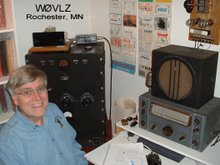 A couple of weeks ago I spotted a radio on ebay that looked really interesting. I've been doing some research on it since then.
A couple of weeks ago I spotted a radio on ebay that looked really interesting. I've been doing some research on it since then. This radio is a three tuber with a tuned RF stage, regenerative detector and a single stage of audio ... not unusual for an early 30s shortwave set except for the mechanical layout. All of the tubes are mounted horizontally with the RF tube projecting through the RF/Detector stage shield. This layout allows for a compact set. The National SW3, for example, is a three tube regen with a tuned RF stage. It measures 9.5"x7"x9". This set is only 7"x5"x6.5", less than half the size of the SW3.
A search found the original described in the June 1931 issue of QST. Ross Hull designed this set to demonstrate the capabilities of the new type 33 audio pentode. He bragged about the gain of the AF stage and being able to drive a speaker to good volume. Why, then, didn't he include a volume control? You have to detune the RF stage if a station is too loud. Along the way, though, Hull did, in typical Hull style, came up with the clever mechanical layout. Hull was also an early VHF advocate/experimenter. This layout allows fairly short leads. I have to wonder if he was thinking ahead to 60MHz when he sat at the drawing board designing this radio.




